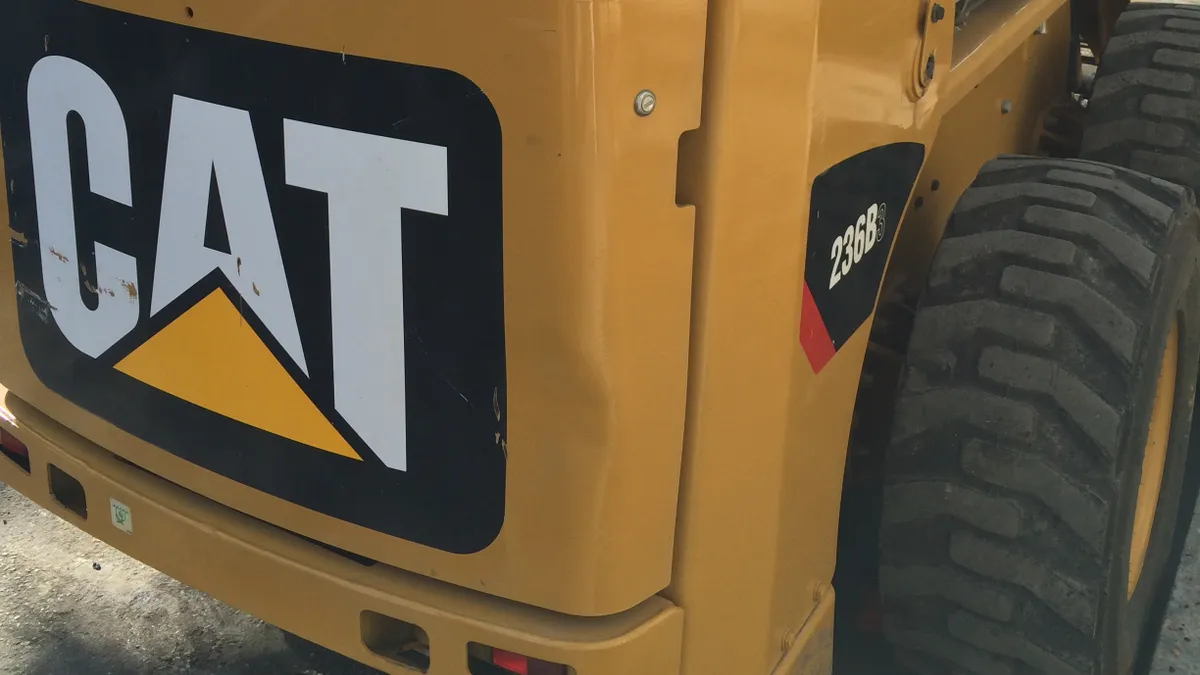Construction jobsites are traditionally low-tech, but ready access to sensor-based technology and digital solutions is spurring a broad shift to more digital operations and innovative ways of working.
At Caterpillar Inc., investments in connectivity and data management tie directly into using analytics and the ability to derive insight for business units, customers and dealers.
The heavy equipment manufacturer has business in the construction, mining and oil and gas industries, which all have a different connectivity strategy. But the investment and framework surrounding connectivity data and analytics is the same, according to Morgan Vawter, chief analytics director at Caterpillar Inc., in a September interview with Construction Dive sister publication CIO Dive.
Broadly, Caterpillar has more than 500,000 connected assets in the field, from large mining trucks to engines to smaller pieces of construction equipment.
Each asset has a number of computers and sensors, which relay different data points about a machine, such as:
- How it's being used
- Where it's located
- How the operator is using the machine
- What different activities it's performing
- Data about safety risks
- When the machine is scheduled for maintenance
Understanding how a machine operates in the field shapes strategies around safety and efficiency. Caterpillar monitors fatigue, a "big risk" in the field, said Vawter.
An in-cab camera detects fatigue events and uses an algorithm to process data offsite. In real-time, Caterpillar can buzz an operator and wake them if there is a safety risk of falling asleep. The company tracks this information for the customer so it can act on data and decide whether an operator needs more breaks.
In an effort to prevent bad things from happening, Caterpillar is also using data to drive assist functionality in its machines, according to Vawter. Ultimately the goal is to make machines more autonomous, which would contribute to operator performance and the consistency of executing certain tasks like digging or excavating.
The allure of efficiency is driving traditionally low-tech sectors like construction to tap equipment manufacturers that can outline a more connected world. Sensors on machines build maps of the world, an initial step in the evolution to autonomous operation, according to Paul Miller, senior analyst at Forrester, in an interview with CIO Dive.
Putting sensors in the cab of a truck is a simple part of the digital shift, Miller said. "The much larger shift is putting sensors everywhere."
Pivoting to a data-filled world
In a fast-paced manufacturing setting or on an active jobsite, data is used to detect anomalies when something — or someone — is operating differently than expected.
"Sensors are becoming so cheap and so inexpensive and you can put them on a lot of things, but you ultimately have to have the use case and the way to create the value from it," Vawter said. "I think that kind of gets lost in the mix of the sexiness of [the internet of things]."
Caterpillar understands the ROI of connected asset data, so decisions on implementation are based on what's driving value for the business and customers.
Part of the decision-making process is knowing when to build vs. buy data and analytics technology, especially as the industry tips toward artificial intelligence and machine learning.
"It's always going to be more cost-effective for us to be an integrator of technology or an innovator on top of an existing technology than it would be to be an inventor of a new technology," Vawter said.
Some of Caterpillar's data and analytics-related projects do come from internal development. Internally, with advanced analytics and AI, the company uses AI for virtual product development, Vawter said. "We actually reduce the amount of time that it takes us to develop a new machine and get it out into the field by simulating a lot of the product testing internally."
Caterpillar can simulate operator performance, using reinforcement learning to understand how an operator may perform with something like excavator leveling.
The model offers Caterpillar a view of the good and bad functionalities the operator might use, which can influence the company's testing and development process.
What's next for data at Caterpillar
Industry is in the early stages of data use, just touching on what is possible with analysis. Data already informs organizations' behavior and decision-making process, but with more reliable streams of data, its role will become enhanced.
When Vawter first arrived at Caterpillar, almost three years ago, the organization was growing in its ability to innovate and experiment, receiving better uptick from the business.
What's changed the most since then is the scale, "the value that we're realizing from analytics and the types of applications that we're applying it to now," she said.
Analytics is also realizing a more end-to-end focus at Caterpillar, where in the past the company was laser-focused on areas like supply chain or product development. Data is now applied to more functional business areas, like marketing or customer interactions.
The goal for the analytics organization is to become a bigger enabler within enterprise strategy, impacting the company's possible growth and offering more easy-to-use solutions for customers.
To be successful and have examples of scale, Caterpillar had to invest in building a foundation for analytics across the company, from data management to the enterprise operating model.
The foundation is what has allowed the analytics organization to be successful and grow. "It's not just [the] one-off solutions that we build."
















